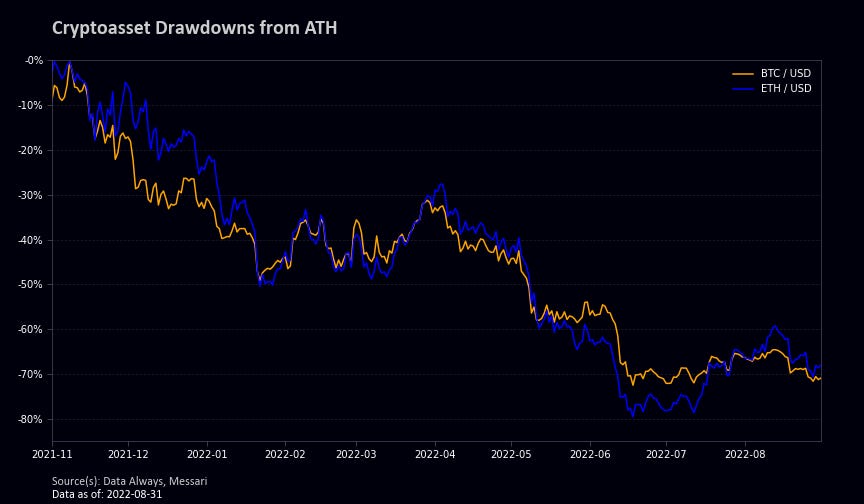What to Expect from the Ethereum Merger
On September 6th, 2022, Ethereum completed the Bellatrix merge. This was the final upgrade before migrating from Proof-of-Work (PoW) to Proof-of-Stake (PoS) on the mainnet. With the merger expected to happen around September 15th, here are a few things I think are essential to be in the know.
With the rise of DeFi and NFTs, the Ethereum network has taken over as the largest value-settled blockchain. The problem is that the fees have become extraordinarily high when the chain is stressed, and the ability to only settle 14 transactions per second hinders growth. These high fees deter new users from exploring the broader ecosystem.
This intersection will reduce energy usage for the Ethereum network by a projected 99.95% compared to PoW. It’s a significant upgrade to allow all the growth that has been happening over the last few years.
Check out this article if you need a refresher on PoW vs. PoS.
Pros and Cons
While most of the proof of stake upgrades are improvements, one of the biggest criticisms is the inherent decentralization issue. Most people cannot afford the required 32 ETH for staking, which mainly allows already wealthy individuals to continue making interest on their principal.
This is one of the benefits of a PoW chain; you get decentralization by enabling people with computers to produce blocks. While mining equipment is expensive, it is much cheaper than 32 ETH, which is $55,000 at current prices.
So in sum, what made ethereum stand out from its competitors was its decentralization and security. This will carry over when it transitions to proof of stake, but maintaining high unique validators as prices increase becomes unattainable to the average user, given the nature of this staking mechanism.
Starting as a proof of work system, at least distributes most of the supply to the public. Achieving this before converting to proof of stake is a benefit as most current PoS competitors are highly centralized:
It’s also no secret that institutions are itching to get their hands on ETH so that they can stake it. Asset managers like Blackrock are entering the ring. It’s only a matter of time before institutions are staking enough ETH to have the power to decide what happens at the protocol level. The recent incident with Tornado Cash gives us insight into how much it could change Ethereum’s ecosystem.
While there is definitely a list of pros and cons, I have always seen Ethereum as more liquid. This mechanism will significantly increase throughput as scaling is updated. If you want to use an asset secured through PoW, you can use Bitcoin as the hard asset.
What to Expect?
We have been running the beacon chain in unison with the current proof of work mechanisms. The merge will bring the current state of all applications on Ethereum with it and will not impact the small-time user. Here are a few things I want to share to help you navigate these unknown times.
This fork will lead to ETH holders being given ETHPoW tokens on a 1:1 basis with their ETH holdings. After the merge, there will be a frenzy to sell these fork tokens, especially large holders, to increase their PoS positions.
The next big event is when the current staked ETH is allowed to begin withdrawing. With no current set date, it has been over two years since the introduction of staking, with participants being unable to touch these funds. The unlocks start within a few months, and roughly 80% of validators are in the red.
I can view this in two ways: Validators in the red will sell and try to recoup their losses. The global markets are cooling off with the inflation rate at 40-year highs.
Or...
ETH validators are putting long-term faith in Ethereum, and the lower price can cause increased purchasing of nodes at prices below the average entry point. ETH/BTC has held up well in the bear market, and with issuance reduced by roughly 90% daily, this can cause a supply shortage as entrants want to begin staking.
Data is leaning towards more accumulation. My thought process is that the merger happening during a risk-off market can have similar effects to bitcoin halving, causing decoupling of the tech stock and BTC's downward trend. If the price remains at these levels until staked withdraws are available, the number of validators choosing to exit may be low.
I am excited about this merger as I have been seeing the progress of Ethereum from the sidelines for years. With staking something I can participate in and the many available platforms to host decentralized staking for individuals with less than 32 ETH(RocketPool/ Lido), I am excited for the next step in the evolution of Ethereum and the following year of scaling upgrades.
If you have any questions, please leave a comment, and I can answer your questions further. As with all of my writing, this is not financial advice and is my opinion. I cannot stress enough how important it is to do your own research on all financial endeavors. I hope these newsletters can help investors realize the current financial systems’ downfalls and usher in a more equitable system without middlemen. Let’s build something together.
Tell your friends and family. This newsletter is targeting entry-level education for possible crypto investors. With more people understanding digital assets, we can finally progress to better. 🗣️
If you enjoyed this article, please consider subscribing to my paid newsletter, which includes my charting indicators for Trading View—for the price of taking me to lunch.






